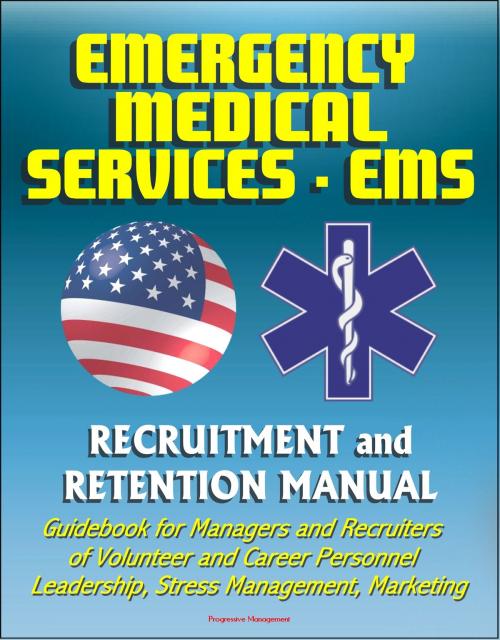Emergency Medical Services (EMS) Recruitment and Retention Manual - Guidebook for Managers and Recruiters of Volunteer and Career Personnel, Leadership, Stress Management, Marketing
Nonfiction, Health & Well Being, Medical, Allied Health Services, Emergency Medical Services| Author: | Progressive Management | ISBN: | 9781476128429 |
| Publisher: | Progressive Management | Publication: | August 11, 2012 |
| Imprint: | Smashwords Edition | Language: | English |
| Author: | Progressive Management |
| ISBN: | 9781476128429 |
| Publisher: | Progressive Management |
| Publication: | August 11, 2012 |
| Imprint: | Smashwords Edition |
| Language: | English |
The United States Fire Administration (USFA) publication Emergency Medical Services (EMS) Recruitment and Retention Manual is a guidebook intended for the use of the managers and recruiters of volunteer personnel in organizations that provide emergency medical services. The manual also may be used productively by EMS organizations. that employ career personnel, especially combined career-volunteer departments.
This manual presents guidance for the managers of emergency medical services (EMS) organizations in the recruitment and retention of volunteer personnel. The knowledge gained from research concerning the use of volunteers in both public and nonprofit agencies has been combined with the experiences, practices, and ideas of EMS agencies that have successfully recruited and retained volunteer members. Practical solutions to common problems in the use of volunteers are suggested, and examples of effective recruitment and retention techniques that may be adopted by a variety of communities are described. The manual does not specify a single, correct way to recruit and retain EMS volunteers. The ideas and alternatives presented for EMS volunteer recruitment and retention are possibilities, which EMS managers may consider and adopt according to local needs, preferences, and limitations.
Volunteerism is a tradition in the United States. Americans have a long history of forming voluntary groups of citizens to work on common problems and interests, and volunteering is one of the most commonplace activities in our society today. In a survey conducted by the Gallup Poll, it was learned that over 80 million adults had volunteered during the previous year and contributed more than 19.5 billion hours of effort. The savings realized by this volunteer activity exceeded 200 billion dollars.
Emergency medical services have depended on volunteer support for many years. The importance of volunteers to the delivery of emergency medical services cannot be overstated. Rural America relies almost totally on the volunteer system to provide EMS and fire services in a timely manner. Suburban America also relies on volunteers, but combination career-volunteer systems are being used more frequently as a way to assist volunteers and to maintain the current EMS system. Funding of the volunteer EMS system by the local community has been very important for the survival of the volunteer EMS system in many cases.
Contents: INTRODUCTION * National Trends in the Volunteer Sector * Volunteerism in the United States * The Role of Leadership in Volunteer Programs * Planning for the Participation of Volunteers * RECRUITMENT * Steps in Recruiting EMS Volunteers * Use of a Dedicated Recruiter * Some Relevant Laws Affecting EMS Recruitment * Diversity in EMS Organizations * MOTIVATION * Motivating Them to Volunteer * Getting Their Attention: Marketing * The Importance of Marketing * The Three Components of Marketing * Planning a Marketing Program * Four Ways to Market * Communications Strategies * Use the EMS PIER Manual * Recruitment Reminder: Be Realistic * What Motivates Them to Volunteer for EMS * Participation in Decisionmaking * Following Up After the Application Is Received * The Unspoken Concerns of Volunteers * Matching Volunteers to Jobs * RETENTION * Volunteer Leadership Issues * Stress Management * Health and Safety Risks * Equipment Concerns * The Performance Review as a Retention Tool * The Exit Interview as a Retention Tool * Retention of Career Staff * RECRUITMENT AND RETENTION STRATEGIES * ANNOTATED BIBLIOGRAPHY RESOURCES
The United States Fire Administration (USFA) publication Emergency Medical Services (EMS) Recruitment and Retention Manual is a guidebook intended for the use of the managers and recruiters of volunteer personnel in organizations that provide emergency medical services. The manual also may be used productively by EMS organizations. that employ career personnel, especially combined career-volunteer departments.
This manual presents guidance for the managers of emergency medical services (EMS) organizations in the recruitment and retention of volunteer personnel. The knowledge gained from research concerning the use of volunteers in both public and nonprofit agencies has been combined with the experiences, practices, and ideas of EMS agencies that have successfully recruited and retained volunteer members. Practical solutions to common problems in the use of volunteers are suggested, and examples of effective recruitment and retention techniques that may be adopted by a variety of communities are described. The manual does not specify a single, correct way to recruit and retain EMS volunteers. The ideas and alternatives presented for EMS volunteer recruitment and retention are possibilities, which EMS managers may consider and adopt according to local needs, preferences, and limitations.
Volunteerism is a tradition in the United States. Americans have a long history of forming voluntary groups of citizens to work on common problems and interests, and volunteering is one of the most commonplace activities in our society today. In a survey conducted by the Gallup Poll, it was learned that over 80 million adults had volunteered during the previous year and contributed more than 19.5 billion hours of effort. The savings realized by this volunteer activity exceeded 200 billion dollars.
Emergency medical services have depended on volunteer support for many years. The importance of volunteers to the delivery of emergency medical services cannot be overstated. Rural America relies almost totally on the volunteer system to provide EMS and fire services in a timely manner. Suburban America also relies on volunteers, but combination career-volunteer systems are being used more frequently as a way to assist volunteers and to maintain the current EMS system. Funding of the volunteer EMS system by the local community has been very important for the survival of the volunteer EMS system in many cases.
Contents: INTRODUCTION * National Trends in the Volunteer Sector * Volunteerism in the United States * The Role of Leadership in Volunteer Programs * Planning for the Participation of Volunteers * RECRUITMENT * Steps in Recruiting EMS Volunteers * Use of a Dedicated Recruiter * Some Relevant Laws Affecting EMS Recruitment * Diversity in EMS Organizations * MOTIVATION * Motivating Them to Volunteer * Getting Their Attention: Marketing * The Importance of Marketing * The Three Components of Marketing * Planning a Marketing Program * Four Ways to Market * Communications Strategies * Use the EMS PIER Manual * Recruitment Reminder: Be Realistic * What Motivates Them to Volunteer for EMS * Participation in Decisionmaking * Following Up After the Application Is Received * The Unspoken Concerns of Volunteers * Matching Volunteers to Jobs * RETENTION * Volunteer Leadership Issues * Stress Management * Health and Safety Risks * Equipment Concerns * The Performance Review as a Retention Tool * The Exit Interview as a Retention Tool * Retention of Career Staff * RECRUITMENT AND RETENTION STRATEGIES * ANNOTATED BIBLIOGRAPHY RESOURCES















